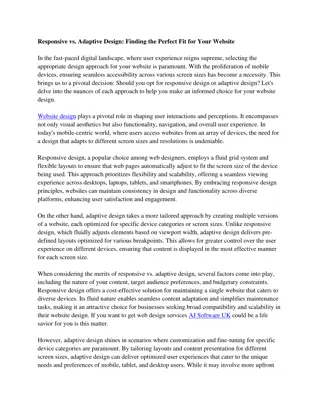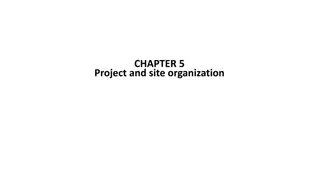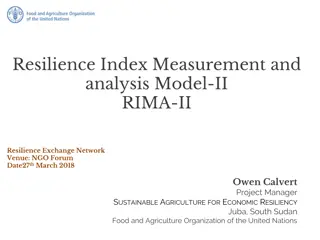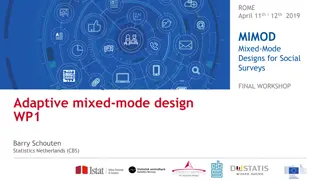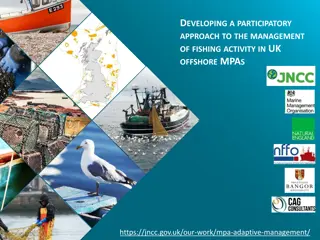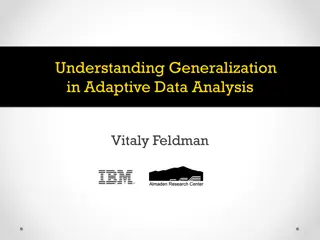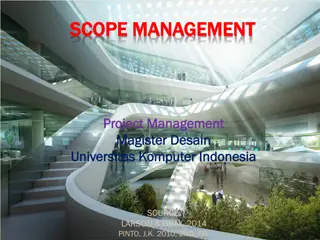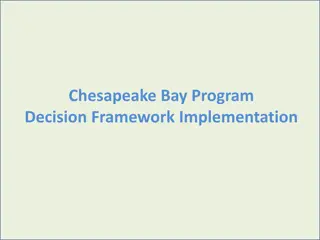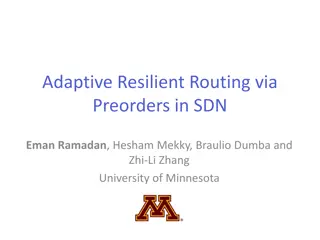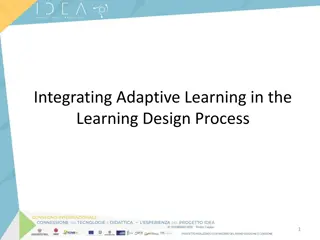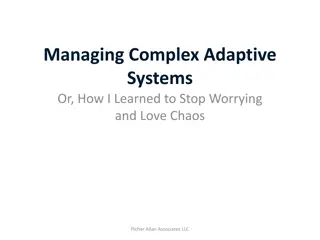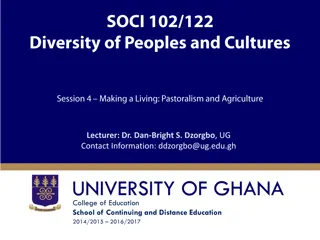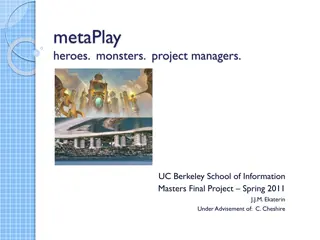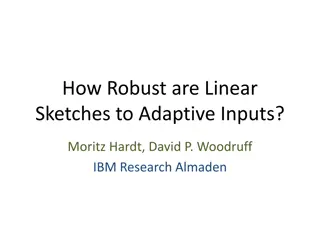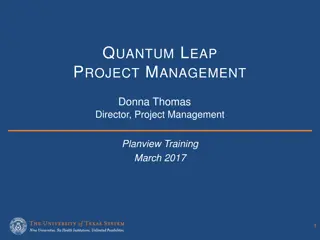Project Organization Structure and Adaptive Management Approach
This content delves into the detailed project organization structure involving various stakeholders and highlights the adaptive management approach for effective project implementation. It covers tools, techniques, and processes essential for assessing, adjusting, and decision-making to achieve desired outcomes. The structure includes stakeholders such as Project Board, Beneficiary Representative, Development Partners, and more. Additionally, it discusses adaptive management tools and approaches like work plans, project reports, evaluations, consultations, and impact assessments. The Project Results Framework is also explored, focusing on strategies, indicators, targets, risks, and conditions necessary for successful project outcomes.
Download Presentation

Please find below an Image/Link to download the presentation.
The content on the website is provided AS IS for your information and personal use only. It may not be sold, licensed, or shared on other websites without obtaining consent from the author.If you encounter any issues during the download, it is possible that the publisher has removed the file from their server.
You are allowed to download the files provided on this website for personal or commercial use, subject to the condition that they are used lawfully. All files are the property of their respective owners.
The content on the website is provided AS IS for your information and personal use only. It may not be sold, licensed, or shared on other websites without obtaining consent from the author.
E N D
Presentation Transcript
Project Organisation Structure Project Board Beneficiary Representative Executive/Project Director Development Partners Beneficiary countries UNDP SRO, Barbados Government of Japan CARICOM Secretariat UNDP RBLAC Regional Hub, Panama OECS Commission Project Assurance Technical Advisory Group UNDP SRO, Barbados UNDP RBLAC Regional Hub, Panama Project Management Unit (UNDP Barbados) CCCCC CIMH CARPHA CANARI CARDI UWI CDEMA UNFCCC RCC Project Manager NAMA and NAP Technical Specialists Communications Specialist Project Associate UNDP Country Offices Belize, Barbados and the OECS, Guyana, Jamaica, Suriname National Focal Points Belize, Dominica, Grenada, Guyana, Jamaica, Saint Lucia, St Vincent and the Grenadines, Suriname
Adaptive Management Assess problem Adjust Reducing uncertainty Active learning Informed decision-making Formal, structured, systematic: not just trial and error Evaluate Design Monitor Implement 3
Adaptive Management Tools and approahces Quarterly, Annual and Multi-year work plans and budget Project Implementation Reports (annual, quarterly) Midterm Review (MTR) Terminal Evaluation (TE) Field Visits, Consultations Impact Assessments Technical Reports Results Framework / LogFrame 4
Project Results Framework Project Document p 54 Project Strategy / Output Indicator Baseline value Target and benchmarks Sources of verification Risks and Assumptions Which result do I want to achieve? In which units do I measure this result? How much of these results units are available before the project is starting? How many results units do I want to achieve, and by when? How and where can I find data and info to verify that this result has been achieved? Which risks could affect achievement of this result? Which conditions are necessary so that I have good chances of achieving this result? (conditions out of project influence)
Application Form for the Pilot Projects under Outcome 2 Output level results: Concrete adaptation measurers, solutions, techniques and technologies introduced and installed (e.g. water storage and capture, irrigation, climate- resilient crops and farming techniques, infrastructure improvements) Activities Steps that lead to the output e.g. site assessment and system design; capacity building in installation and maintenance; system installation and testing Indicators Used to measure success in relation to the result. Must be SMART (specific, measurable, achievable, relevant, time-bound) e.g. m3 of water storage installed or repaired Baseline Status before pilot starts relative to the indicators e.g. 150m3 existing water storage capacity resulting at community centre, however pump is inoperable and tank has small leak Targets Goal to be reached by pilot end relative to the baseline e.g. 3,150m3 of water storage capacity available (3,000 m3 installed, 150m3 repaired) Measuring method Describe source, method and frequency of data collection Outcome level results: Cumulative impacts of the outputs installed in reducing vulnerability and enhance resilience of communities (e.g. reduction of disruption in water or food-supply caused by drought or storm situations, or enhanced availability of drinking quality water and increased crop yields) Outputs Recapping and listing of outputs detailed above leading to the vulnerability reduction outcome(s) Indicators Used to measure success in relation to the result. Must be SMART (specific, measurable, achievable, relevant, time-bound) e.g. Litres of drinking water per capita per day increase or available year round and in drought periods Baseline Status before pilot starts relative to the indicators e.g. 50 litres of drinking water per capita per day available during drought period. Targets Goal to be reached by pilot end relative to the baseline e.g. 200 litres of drinking water per capita per day available during drought period. Measuring method Describe source, method and frequency of data collection
Multi-Year Work-plan, Annual Work-plan Year: 2016-2017 2016 2017 PLANNED BUDGET IMPLEMEN TATION ENTITY EXPECTED OUTPUTS PLANNED ACTIVITIES Acc. Code Amount (US$) 2016 Amount (US$) 2017 Funding Source J F M A M J J A S O N D J F M A M J J A S O N D Budget Description OUTPUT 1 Output 1.1: The provision of technical support towards national and sub-national institutional and coordination arrangements in 8 participant countries to support the formulation of national roadmaps on the NAP process, including elements for monitoring the progress of their implementation Yoko Ebisawa: 90days*8countries 1.1.1 NAP Baseline Assessments - Synthesize available information, resources, programmes, development goals, etc - Identify development - adaptation themes and goals/objectives to focus on - Define mandate & strategy, and national institutional arrangements 71200 International Consultants 448,000.00 224,000.00 71600 Travel 95,778.67 47,889.33 Yoko Ebisawa: Baseline assessment together with NAMA and community based activities 1.1.2 Development of NAPs and Roadmaps - Review existing legal, policy and regulatory frameworks to determine modalities for providing incentives for adaptation investments - Establish implementation strategy for effective integration of actions outlined in the roadmap into development plans and policies - Stakeholder validation UNDP GOJ Contractual Services - Individ Indicators: Baseline: Targets: Year 2017 - 6 countries developed NAPs or NAP Road maps 71400 25,950.50 25,950.50 72600 Grants - - Total Activity 1.1.1 569,729.17 297,839.83 Neisha Manickchand: Availability of resource person and people to be trained 1.2 National teams are trained in the use of tools, methods and approaches to advance the NAP process and budgeting 1.2.1 Determination of training and equipment needs for NAP process - Undertake the survey to assess the needs and gaps for materials, methods, and tools that are relevant for informing the NAP process 71600 Travel 44,010.67 22,005.33 Target Year 2016 - Tools, methods, and guidelines to advance the NAP processes were provided in at least 6 countries 1.2.2 Conduct capacity development programme - Promote the use of existing training materials, methods and tools on the basis of the needs identified - Strengthen leadership within key ministries - Integrate adaptation costing into sector plans and public investment plans through macro and analysis of policy instruments - Tools, methods, and guidelines to advance the NAP process are developed / adopted for countries in partnership with other agencies and organizations Neisha Manickchand: Include general training 71200 International Consultants 24,000.00 24,000.00 UNDP GOJ Training, Workshops and Confer 75700 107,894.50 73,360.10 Total Activity 1.2 175,905.17 119,365.43
Inception Report Quarterly Progress Reports Annual Project Report Technical Reports Project Publications Mid-term and final evaluation reports Audit Report
Risk Management Why manage risk in a project? projects are complex and therefore likely to face risks and challenges Strengthen project and portfolio management (efficiency and effectiveness) 9
Risk Management Seven Risk Categories Natural disasters Seasonal extremes ENVIRONMENTAL External: interest rates, exchange rate fluctuations, etc. Internal: co-funding difficulties; financial mechanisms FINANCIAL Complex design Negligence/incompetence Poor M&E; slow delivery OPERATIONAL Institutional / implementation arrangements Institutional / Execution capacity ORGANIZATIONAL Government commitment; political will Political instability; change in government POLITICAL New unexpected regulations, policies Critical policy/legislation fail to pass REGULATORY Partnerships failing to deliver Mismatch between project scope/ambition and capacity STRATEGIC 10
# Description Community not supportive of proposed interventions Date Identified Type Impact & Probability Most of the interventions identified have not been validated with community level stakeholders. P = 2, I = 5 Countermeasures / Mngt response UNDP has developed a visibility, communication and stakeholder engagement strategy which will ensure that all community based actions are implemented with the free, prior and informed consent of all stakeholders at community level. 1 December 2014 Social/Political Slow financial delivery due to limited national absorption capacity Slow financial delivery can result in disrupting the project s timeframe and result in inability to achieve results on time P = 3, I = 4 UNDP has decided to use the Direct Implementation Modality, which gives greater control for organisation or project outputs 2 December 2014 Financial Hazard impact such as from a hurricane could severely delay project activities and result in inability to deliver project activities or even cause destruction to infrastructure. In compliance with its corporate policy, the operation of PMU in Barbados will be covered by UNDP s Barbados Business Continuity plan. This is also applicable to other project operations in other UNDP offices . 3 Natural hazard impact December 2014 Environmental This would provide an opportunity for demonstrating the value of the project investment in execution of the capacities built; or through support from the wider region in applying such capacities to the affected country if not yet built locally. UNDP is undertaking wide consultations with national actors and ensuring alignment between project priorities and national development needs. It would also divert national priorities and resources to response, recovery and reconstruction efforts. P = 5, I = 5 Change in government can mean new priorities and, in some cases unwillingness to continue with development initiatives of a previous administration P = 3, I-5 4 Change in Government December 2014 Political
Project Document p69 M&E Work Plan and Budget Multi-Year Work-Plan 4. 1 Inception/launch and Project Board Meetings 4.1.1 Inception/launch 61100 Salary NP staff 255,837.80 255,837.80 4.1.2 Project Board Meeting 71400 Contractual Services - Individ 41,371.26 41,371.26 4.1.3 In-Country launch 72200 Equipment and Furniture 21,500.00 15,988.71 4.2 Project implementation and monitoring 4.2.1 Quartery Progress Report Communic & Audio Visual Equip 72400 8,300.00 34,655.99 4.2.2 Annual Report 71200 International Consultants 40,000.00 40,000.00 4.2.3 Project Terminal Report UNDP GOJ 74100 Professional Services - 20,000.00 4.2.4 Monitoring Mission 71300 Local Consultants 25,531.25 25,531.25 4.2.5 Mid-term Evaluation Training, Workshops and Confer 75700 36,351.79 - 4.2.6 Final Evaluation 71600 Travel 92,500.00 92,500.00 4.2.7 Audit 74500 Miscellaneous Expenses 117,330.18 117,330.18




